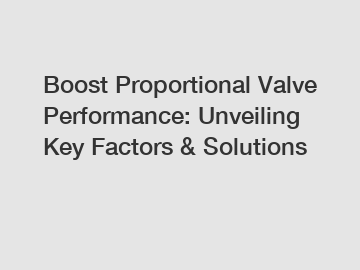Boost Proportional Valve Performance: Unveiling Key Factors & Solutions
Proportional valves are invaluable components used in various industries, offering precise control and regulation of fluid flow rates. These valves play a vital role in hydraulic and pneumatic systems, enabling smooth operations in critical applications such as manufacturing, robotics, and automotive systems.
However, even the most advanced proportional valves can face challenges that impede their performance, resulting in decreased efficiency and potential malfunctions. In this blog, we will explore the key factors influencing proportional valve performance and uncover effective solutions to optimize their functionality.
1. Valve Design and Construction.

The construction and design of a proportional valve lay the foundation for its overall performance. Manufacturers invest substantial resources in research and development to design valves that meet the industry's stringent requirements. Design factors that affect performance include valve response time, resolution, repeatability, and flow dynamics.
For optimal performance, it is crucial to select a proportional valve that is specifically designed for the intended application, considering parameters such as pressure range, flow rates, and response times. Consulting an expert or engaging with a reputable valve manufacturer can ensure the best-fit valve for your specific needs.
2. Fluid Compatibility and Cleanliness.
Fluid compatibility is a critical consideration to maintain proportional valve efficiency and longevity. Many industrial fluids, such as hydraulic oil or chemicals, can create issues like seal degradation or corrosion, impacting valve performance. Ensure that the selected valve is compatible with the operating fluid.
Furthermore, maintaining proper fluid cleanliness is essential to prevent contaminants from entering the valve. Impurities like particles, metal shavings, or water can cause blockages, affecting valve responsiveness. Employing effective filtration systems and regularly monitoring fluid cleanliness levels can significantly enhance proportional valve performance.
3. Pressure and Flow Control.
Precise control of pressure and flow rates is crucial to optimizing the performance of proportional valves. Incorrect pressure settings, fluctuations, or inadequate flow control will lead to erratic valve behavior, reduced accuracy, and potential damage to the system.
It is recommended to incorporate pressure regulators, flow meters, and other control devices to ensure stable pressure and accurate flow rates within the valve's operational range. Regular monitoring, adjustment, and calibration can further guarantee consistent performance and prevent issues arising from pressure or flow variations.
4. Electrical Interfaces and Control Signals.
Proportional valves rely on electrical interfaces and control signals to regulate fluid flow accurately. The compatibility of control signals, wiring, and electrical connections is essential for seamless valve operation. Any deviations or poor connections can lead to erratic valve behavior, imprecise control, or even complete failure.
Investing in systems that integrate seamlessly with proportional valves, such as programmable logic controllers (PLCs) or dedicated control units, can improve performance and simplify control signal management. Adequate shielding, grounding, and robust connections between electrical components ensure reliable and accurate communication.
5. Maintenance and Periodic Servicing.
Regular maintenance and periodic servicing play a crucial role in preserving the optimal performance of proportional valves. Over time, wear and tear, as well as debris accumulation, can diminish valve efficiency and responsiveness. Following manufacturer recommendations for maintenance intervals and procedures is vital to ensure continued peak performance.
Scheduled inspections, cleaning, and lubrication can help prolong the valve's lifespan and prevent potential malfunctions. If any issues or abnormalities are identified during routine maintenance, timely intervention or expert assistance can save valuable time and resources in preventing severe damage.
Conclusion.
Proportional valves are vital components in industrial applications, enabling precise control and regulation of fluid flow rates. By understanding the key factors influencing valve performance and implementing effective solutions, such as selecting the right valve, ensuring fluid compatibility and cleanliness, controlling pressure and flow accurately, managing electrical interfaces, and maintaining regular servicing, one can optimize proportional valve functionality.
By prioritizing these factors and following best practices, you can enhance the performance, efficiency, and reliability of your proportional valves, ultimately leading to improved overall system operations and productivity.
For more information, please visit electro-hydraulic pilot relief valve factory, Electromagnetic Ball Valve, wholesale Hydraulic Control Check Valve Supplier.

Comments